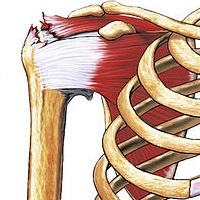
Photo from wikipedia
Objectives: The purpose of the current study was to investigate clinical outcomes in overhead athletes undergoing biceps tenodesis for the treatment of symptomatic, isolated SLAP tears involving the biceps-labral complex.… Click to show full abstract
Objectives: The purpose of the current study was to investigate clinical outcomes in overhead athletes undergoing biceps tenodesis for the treatment of symptomatic, isolated SLAP tears involving the biceps-labral complex. Methods: A retrospective review of overhead athletes who underwent biceps tenodesis for a SLAP tear was performed. The American Shoulder & Elbow Surgeons (ASES) score, Visual Analogue Scale (VAS), Subjective Shoulder Value (SSV), patient satisfaction, willingness to undergo surgery again, revisions, and return to play (RTP) were evaluated. Psychological readiness to return to sport was evaluated using the SLAP-Return to Sport after Injury (SLAP-RSI) score. A p value of <0.05 was considered to be statistically significant. Results: The current study included 44 overhead athletes. The mean age was 34.9 (16-46), 79.5% were males, and the mean follow-up was 49 months (18-107). Overall, we found that 81.8% of patients returned to play their overhead sport following biceps tenodesis, and 59.1% of patients returned to the same or higher level of play. It took patients on average 8.7 months to return to play following biceps tenodesis. The mean SLAP-RSI score was 69.3, and 70.5 % of patients passed the SLAP-RSI threshold of 56. The mean scores for ASES, VAS, SSV, and satisfaction were 92, 0.8, 80.5, and 87.9%, respectively. No patients in our cohort required a revision surgery. Conclusions: This study found that athletes undergoing biceps tenodesis as the treatment for a symptomatic, isolated SLAP tear had a high rate of return to play, good functional outcomes, and a low rate of revision surgery.
Journal Title: Orthopaedic Journal of Sports Medicine
Year Published: 2022
Link to full text (if available)
Share on Social Media: Sign Up to like & get
recommendations!